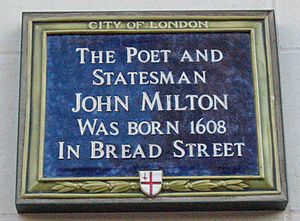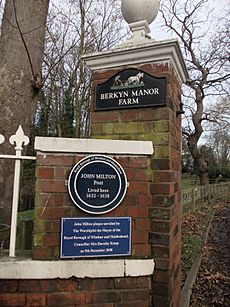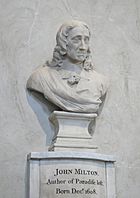John Milton facts for kids
Quick facts for kids
John Milton
|
|
|---|---|
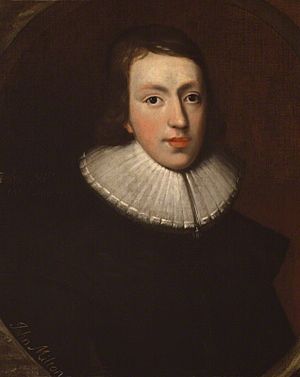
Portrait of Milton, c. 1629
|
|
| Born | 9 December 1608 Bread Street, Cheapside, London, England
|
| Died | 8 November 1674 (aged 65) Bunhill Row, London, England
|
| Resting place | St Giles-without-Cripplegate |
| Alma mater | Christ's College, Cambridge |
| Occupation |
|
| Spouse(s) |
Mary Powell
(m. 1642; Katherine Woodcock
(m. 1656; Elizabeth Mynshull
(m. 1663) |
| Children | 5 |
| Writing career | |
| Language | English, Latin, Greek, Hebrew, French, Spanish, Italian, Old English, Dutch, Aramaic, Syriac |
| Notable works | Paradise Lost Areopagitica Lycidas |
| Signature | |
John Milton (9 December 1608 – 8 November 1674) was an English poet and intellectual. His 1667 epic poem Paradise Lost, written in blank verse and including over ten chapters, was written in a time of immense religious flux and political upheaval. It addressed the fall of man, including the temptation of Adam and Eve by the fallen angel Satan and God's expulsion of them from the Garden of Eden. Paradise Lost elevated Milton's reputation as one of history's greatest poets. He also served as a civil servant for the Commonwealth of England under its Council of State and later under Oliver Cromwell.
Milton achieved fame and recognition during his lifetime, his celebrated Areopagitica (1644), written in condemnation of pre-publication censorship, is among history's most influential and impassioned defences of freedom of speech and freedom of the press. His desire for freedom extended beyond his philosophy and was reflected in his style, which included his introduction of new words (coined from Latin and Ancient Greek) to the English language. He was the first modern writer to employ unrhymed verse outside of the theatre or translations.
Milton is described as the "greatest English author" by biographer William Hayley, and he remains generally regarded "as one of the preeminent writers in the English language", though critical reception has oscillated in the centuries since his death often on account of his republicanism. Samuel Johnson praised Paradise Lost as "a poem which...with respect to design may claim the first place, and with respect to performance, the second, among the productions of the human mind", though he (a Tory) described Milton's politics as those of an "acrimonious and surly republican". Milton was revered by poets such as William Blake, William Wordsworth, and Thomas Hardy.
Phases of Milton's life parallel the major historical and political divisions in Stuart England at the time. In his early years, Milton studied at Christ's College at the University of Cambridge, one of the world's most prestigious universities, and then travelled, wrote poetry mostly for private circulation, and launched a career as pamphleteer and publicist under Charles I's increasingly autocratic rule and Britain's breakdown into constitutional confusion and ultimately civil war. While once considered dangerously radical and heretical, Milton contributed to a seismic shift in accepted public opinions during his life that ultimately elevated him to public office in England. The Restoration of 1660 and his loss of vision later deprived Milton much of his public platform, but he used the period to develop many of his major works.
Milton's views developed from extensive reading, travel, and experience that began with his days as a student at Cambridge in the 1620s and continued through the English Civil War, which started in 1642 and continued through 1651. By the time of his death in 1674, Milton was impoverished and on the margins of English intellectual life but famous throughout Europe and unrepentant for political choices that placed him at odds with governing authorities.
Contents
Early life and education

John Milton was born in Bread Street, London, on 9 December 1608, the son of composer John Milton and his wife Sarah Jeffrey. The senior John Milton (1562–1647) moved to London around 1583 after being disinherited by his devout Catholic father Richard "the Ranger" Milton for embracing Protestantism. In London, the senior John Milton married Sarah Jeffrey (1572–1637) and found lasting financial success as a scrivener. He lived in and worked from a house in Cheapside, at Bread Street where the Mermaid Tavern was located. The elder Milton was noted for his skill as a musical composer, and this talent left his son with a lifelong appreciation for music and friendships with musicians such as Henry Lawes.
The prosperity of Milton's father allowed his eldest son to obtain a private tutor, Thomas Young, a Scottish Presbyterian with a MA from the University of St Andrews. Young's influence also served as the poet's introduction to religious radicalism. After Young's tutorship, Milton attended St Paul's School in London, where he began the study of Latin and Greek; the classical languages left an imprint on both his poetry and prose in English (he also wrote in Latin and Italian).
Milton's first datable compositions are two psalms written at age 15 at Long Bennington. One contemporary source is Brief Lives of John Aubrey, an uneven compilation including first-hand reports. In the work, Aubrey quotes Christopher, Milton's younger brother: "When he was young, he studied very hard and sat up very late, commonly till twelve or one o'clock at night". Aubrey adds, "His complexion exceeding faire—he was so faire that they called him the Lady of Christ's College."
In 1625, Milton gained entry to Christ's College at the University of Cambridge, where he graduated with a BA in 1629, ranking fourth of 24 honours graduates that year in the University of Cambridge. Then preparing to become an Anglican priest, Milton then pursued his Master of Arts degree at Cambridge, which he received on 3 July 1632.
Milton may have been rusticated (suspended) in his first year at Cambridge for quarrelling with his tutor, Bishop William Chappell. He was certainly at home in London in the Lent Term 1626; there he wrote Elegia Prima, his first Latin elegy, to Charles Diodati, a friend from St Paul's. Based on remarks of John Aubrey, Chappell "whipt" Milton. This story is now disputed, though certainly Milton disliked Chappell. Historian Christopher Hill notes that Milton was apparently rusticated, and that the differences between Chappell and Milton may have been either religious or personal. It is also possible that, like Isaac Newton four decades later, Milton was sent home from Cambridge because of the plague, which impacted Cambridge significantly in 1625.
At Cambridge, Milton was on good terms with Edward King; he later dedicated "Lycidas" to him. Milton also befriended Anglo-American dissident and theologian Roger Williams. Milton tutored Williams in Hebrew in exchange for lessons in Dutch. Despite developing a reputation for poetic skill and general erudition, Milton suffered from alienation among his peers during his time at Cambridge. Having once watched his fellow students attempting comedy upon the college stage, he later observed, "they thought themselves gallant men, and I thought them fools".
Milton also was disdainful of the university curriculum, which consisted of stilted formal debates conducted in Latin on abstruse topics. His own corpus is not devoid of humour, notably his sixth prolusion and his epitaphs on the death of Thomas Hobson. While at Cambridge, he wrote a number of his well-known shorter English poems, including "On the Morning of Christ's Nativity", "Epitaph on the admirable Dramaticke Poet, W. Shakespeare" (his first poem to appear in print), L'Allegro, and Il Penseroso.
Study, poetry, and travel
Upon receiving his M.A. in 1632, Milton retired to Hammersmith, his father's new home since the previous year. He also lived at Horton, Berkshire, from 1635 and undertook six years of self-directed private study. Hill argues that this was not retreat into a rural idyll; Hammersmith was then a "suburban village" falling into the orbit of London, and even Horton was becoming deforested and suffered from the plague. He read both ancient and modern works of theology, philosophy, history, politics, literature, and science in preparation for a prospective poetical career. Milton's intellectual development can be charted via entries in his commonplace book (like a scrapbook), now in the British Library. As a result of such intensive study, Milton is considered to be among the most learned of all English poets. In addition to his years of private study, Milton had command of Latin, Greek, Hebrew, French, Spanish, and Italian from his school and undergraduate days; he also added Old English to his linguistic repertoire in the 1650s while researching his History of Britain, and probably acquired proficiency in Dutch soon after.
Milton continued to write poetry during this period of study; his Arcades and Comus were both commissioned for masques composed for noble patrons, connections of the Egerton family, and performed in 1632 and 1634 respectively. Comus argues for the virtuousness of temperance and chastity. He contributed his pastoral elegy Lycidas to a memorial collection for one of his fellow-students at Cambridge. Drafts of these poems are preserved in Milton's poetry notebook, known as the Trinity Manuscript because it is now kept at Trinity College, Cambridge.
In May 1638, accompanied by a manservant, Milton embarked upon a tour of France and Italy for 15 months that lasted until July or August 1639. His travels supplemented his study with new and direct experience of artistic and religious traditions, especially Roman Catholicism. He met famous theorists and intellectuals of the time, and was able to display his poetic skills. For specific details of what happened within Milton's "grand tour", there appears to be just one primary source: Milton's own Defensio Secunda. There are other records, including some letters and some references in his other prose tracts, but the bulk of the information about the tour comes from a work that, according to Barbara Lewalski, "was not intended as autobiography but as rhetoric, designed to emphasise his sterling reputation with the learned of Europe."
He first went to Calais and then on to Paris, riding horseback, with a letter from diplomat Henry Wotton to ambassador John Scudamore. Through Scudamore, Milton met Hugo Grotius, a Dutch law philosopher, playwright, and poet. Milton left France soon after this meeting. He travelled south from Nice to Genoa, and then to Livorno and Pisa. He reached Florence in July 1638. While there, Milton enjoyed many of the sites and structures of the city. His candour of manner and erudite neo-Latin poetry earned him friends in Florentine intellectual circles, and he met the astronomer Galileo who was under house arrest at Arcetri, as well as others. Milton probably visited the Florentine Academy and the Accademia della Crusca along with smaller academies in the area, including the Apatisti and the Svogliati.
He left Florence in September to continue to Rome. With the connections from Florence, Milton was able to have easy access to Rome's intellectual society. His poetic abilities impressed those like Giovanni Salzilli, who praised Milton within an epigram. In late October, Milton attended a dinner given by the English College, Rome, despite his dislike for the Society of Jesus, meeting English Catholics who were also guests—theologian Henry Holden and the poet Patrick Cary. He also attended musical events, including oratorios, operas, and melodramas. Milton left for Naples toward the end of November, where he stayed only for a month because of the Spanish control. During that time, he was introduced to Giovanni Battista Manso, patron to both Torquato Tasso and to Giambattista Marino.
Originally, Milton wanted to leave Naples in order to travel to Sicily and then on to Greece, but he returned to England during the summer of 1639 because of what he claimed in Defensio Secunda were "sad tidings of civil war in England." Matters became more complicated when Milton received word that his childhood friend Diodati had died. Milton in fact stayed another seven months on the continent, and spent time at Geneva with Diodati's uncle after he returned to Rome. In Defensio Secunda, Milton proclaimed that he was warned against a return to Rome because of his frankness about religion, but he stayed in the city for two months and was able to experience Carnival and meet Lukas Holste, a Vatican librarian who guided Milton through its collection. He was introduced to Cardinal Francesco Barberini who invited Milton to an opera hosted by the Cardinal. Around March, Milton travelled once again to Florence, staying there for two months, attending further meetings of the academies, and spending time with friends. After leaving Florence, he travelled through Lucca, Bologna, and Ferrara before coming to Venice. In Venice, Milton was exposed to a model of Republicanism, later important in his political writings, but he soon found another model when he travelled to Geneva. From Switzerland, Milton travelled to Paris and then to Calais before finally arriving back in England in either July or August 1639.
Civil war, prose tracts, and marriage
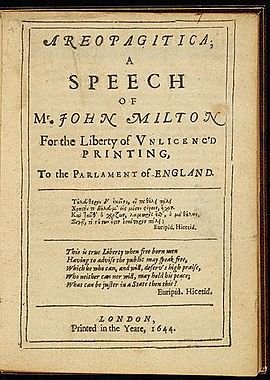
On returning to England where the Bishops' Wars presaged further armed conflict, Milton began to write prose tracts against episcopacy, in the service of the Puritan and Parliamentary cause. Milton's first foray into polemics was Of Reformation touching Church Discipline in England (1641), followed by Of Prelatical Episcopacy, the two defences of Smectymnuus (a group of Presbyterian divines named from their initials; the "TY" belonged to Milton's old tutor Thomas Young), and The Reason of Church-Government Urged against Prelaty. He vigorously attacked the High-church party of the Church of England and their leader William Laud, Archbishop of Canterbury.
He was supported by his father's investments, but Milton became a private schoolmaster at this time, educating his nephews and other children of the well-to-do. This experience and discussions with educational reformer Samuel Hartlib led him to write his short tract Of Education in 1644, urging a reform of the national universities.
In June 1642, Milton paid a visit to the manor house at Forest Hill, Oxfordshire, and, aged 34, married the 17-year-old Mary Powell. The marriage got off to a poor start as Mary did not adapt to Milton's austere lifestyle or get along with his nephews. Milton found her intellectually unsatisfying and disliked the royalist views she had absorbed from her family. Mary soon returned home to her parents and did not come back until 1645, partly because of the outbreak of the Civil War. She bore him two daughters in quick succession following their reconciliation.
Secretary for Foreign Tongues
With the Parliamentary victory in the Civil War, Milton used his pen in defence of the republican principles represented by the Commonwealth. The Tenure of Kings and Magistrates (1649) defended the right of the people to hold their rulers to account, and implicitly sanctioned the regicide; Milton's political reputation got him appointed Secretary for Foreign Tongues by the Council of State in March 1649. His main job description was to compose the English Republic's foreign correspondence in Latin and other languages, but he also was called upon to produce propaganda for the regime and to serve as a censor.
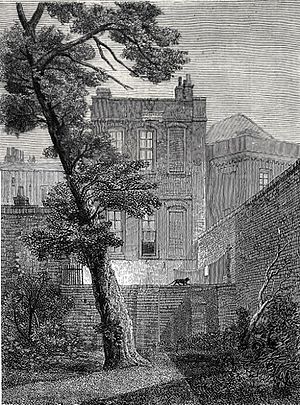
In October 1649, he published Eikonoklastes, an explicit defence of the regicide, in response to the Eikon Basilike, a phenomenal best-seller popularly attributed to Charles I that portrayed the King as an innocent Christian martyr. A month later the exiled Charles II and his party published the defence of monarchy Defensio Regia pro Carolo Primo, written by leading humanist Claudius Salmasius. By January of the following year, Milton was ordered to write a defence of the English people by the Council of State. Milton worked more slowly than usual, given the European audience and the English Republic's desire to establish diplomatic and cultural legitimacy, as he drew on the learning marshalled by his years of study to compose a riposte.
On 24 February 1652, Milton published his Latin defence of the English people Defensio pro Populo Anglicano, also known as the First Defence. Milton's pure Latin prose and evident learning exemplified in the First Defence quickly made him a European reputation, and the work ran to numerous editions. He addressed his Sonnet 16 to 'The Lord Generall Cromwell in May 1652' beginning "Cromwell, our chief of men...", although it was not published until 1654.
In 1654, Milton completed the second defence of the English nation Defensio secunda in response to an anonymous Royalist tract "Regii Sanguinis Clamor ad Coelum Adversus Parricidas Anglicanos" [The Cry of the Royal Blood to Heaven Against the English Parricides], a work that made many personal attacks on Milton. The second defence praised Oliver Cromwell, now Lord Protector, while exhorting him to remain true to the principles of the Revolution. Alexander Morus, to whom Milton wrongly attributed the Clamor (in fact by Peter du Moulin), published an attack on Milton, in response to which Milton published the autobiographical Defensio pro se in 1655. Milton held the appointment of Secretary for Foreign Tongues to the Commonwealth Council of State until 1660, although after he had become totally blind, most of the work was done by his deputies, Georg Rudolph Wecklein, then Philip Meadows, and from 1657 by the poet Andrew Marvell.
By 1652, Milton had become totally blind; the cause of his blindness is debated but bilateral retinal detachment or glaucoma are most likely. His blindness forced him to dictate his verse and prose to amanuenses who copied them out for him; one of these was Andrew Marvell. One of his best-known sonnets, When I Consider How My Light is Spent, titled by a later editor, John Newton, "On His Blindness", is presumed to date from this period.
The Restoration
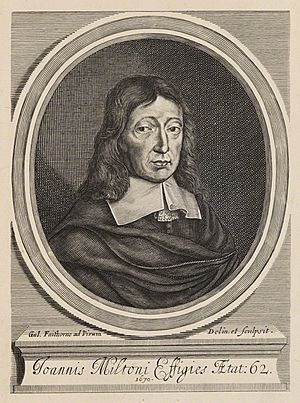
Cromwell's death in 1658 caused the English Republic to collapse into feuding military and political factions. Milton, however, stubbornly clung to the beliefs that had originally inspired him to write for the Commonwealth. In 1659, he published A Treatise of Civil Power, attacking the concept of a state-dominated church (the position known as Erastianism), as well as Considerations touching the likeliest means to remove hirelings, denouncing corrupt practises in church governance. As the Republic disintegrated, Milton wrote several proposals to retain a non-monarchical government against the wishes of parliament, soldiers, and the people.
- A Letter to a Friend, Concerning the Ruptures of the Commonwealth, written in October 1659, was a response to General Lambert's recent dissolution of the Rump Parliament.
- Proposals of certain expedients for the preventing of a civil war now feared, written in November 1659.
- The Ready and Easy Way to Establishing a Free Commonwealth, in two editions, responded to General Monck's march towards London to restore the Long Parliament (which led to the restoration of the monarchy). The work is an impassioned, bitter, and futile jeremiad damning the English people for backsliding from the cause of liberty and advocating the establishment of an authoritarian rule by an oligarchy set up by unelected parliament.
Upon the Restoration in May 1660, Milton, fearing for his life, went into hiding, while a warrant was issued for his arrest and his writings were burnt. He re-emerged after a general pardon was issued, but was nevertheless arrested and briefly imprisoned before influential friends intervened, such as Marvell, now an MP. Milton married for a third and final time on 24 February 1663, marrying Elizabeth (Betty) Minshull, aged 24, a native of Wistaston, Cheshire. He spent the remaining decade of his life living quietly in London, only retiring to a cottage during the Great Plague of London—Milton's Cottage in Chalfont St. Giles, his only extant home.
During this period, Milton published several minor prose works, such as the grammar textbook Art of Logic and a History of Britain. His only explicitly political tracts were the 1672 Of True Religion, arguing for toleration (except for Catholics), and a translation of a Polish tract advocating an elective monarchy. Both these works were referred to in the Exclusion debate, the attempt to exclude the heir presumptive from the throne of England—James, Duke of York—because he was Roman Catholic. That debate preoccupied politics in the 1670s and 1680s and precipitated the formation of the Whig party and the Glorious Revolution.
Death
Milton died on 8 November 1674 and was buried in the church of St Giles-without-Cripplegate, Fore Street, London. However, sources differ as to whether the cause of death was consumption or gout. A monument was added in 1793, sculpted by John Bacon the Elder.
Family
Milton and his first wife Mary Powell (1625–1652) had four children:
- Anne (born 29 July 1646)
- Mary (born 25 October 1648)
- John (16 March 1651 – June 1652)
- Deborah (2 May 1652 – 10 August 1727)
Mary Powell died on 5 May 1652 from complications following Deborah's birth. Milton's daughters survived to adulthood, but he always had a strained relationship with them.
On 12 November 1656, Milton was married to Katherine Woodcock at St Margaret's, Westminster. She died on 3 February 1658, less than four months after giving birth to her daughter Katherine, who also died.
Milton married for a third time on 24 February 1663 to Elizabeth Mynshull or Minshull (1638–1728), the niece of Thomas Mynshull, a wealthy apothecary and philanthropist in Manchester. The marriage took place at St Mary Aldermary in the City of London. Despite a 31-year age gap, the marriage seemed happy, according to John Aubrey, and lasted more than 12 years until Milton's death. (A plaque on the wall of Mynshull's House in Manchester describes Elizabeth as Milton's "3rd and Best wife".) Samuel Johnson, however, claims that Mynshull was "a domestic companion and attendant" and that Milton's nephew Edward Phillips relates that Mynshull "oppressed his children in his lifetime, and cheated them at his death".
His nephews, Edward and John Phillips (sons of Milton's sister Anne), were educated by Milton and became writers themselves. John acted as a secretary, and Edward was Milton's first biographer.
Poetry
Milton's poetry was slow to see the light of day, at least under his name. His first published poem was "On Shakespeare" (1630), anonymously included in the Second Folio edition of William Shakespeare's plays in 1632. An annotated copy of the First Folio has been suggested to contain marginal notes by Milton. Milton collected his work in 1645 Poems in the midst of the excitement attending the possibility of establishing a new English government. The anonymous edition of Comus was published in 1637, and the publication of Lycidas in 1638 in Justa Edouardo King Naufrago was signed J. M. Otherwise. The 1645 collection was the only poetry of his to see print until Paradise Lost appeared in 1667.
Paradise Lost
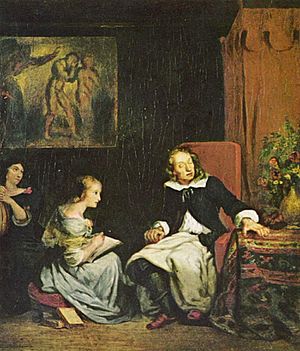
Milton's magnum opus, the blank-verse epic poem Paradise Lost, was composed by the blind and impoverished Milton from 1658 to 1664 (first edition), with small but significant revisions published in 1674 (second edition). As a blind poet, Milton dictated his verse to a series of aides in his employ. It has been argued that the poem reflects his personal despair at the failure of the Revolution yet affirms an ultimate optimism in human potential. Some literary critics have argued that Milton encoded many references to his unyielding support for the "Good Old Cause".
On 27 April 1667, Milton sold the publication rights for Paradise Lost to publisher Samuel Simmons for £5 (equivalent to approximately £770 in 2015 purchasing power), with a further £5 to be paid if and when each print run sold out of between 1,300 and 1,500 copies. The first run was a quarto edition priced at three shillings per copy (about £23 in 2015 purchasing power equivalent), published in August 1667, and it sold out in eighteen months.
Milton followed up the publication Paradise Lost with its sequel Paradise Regained, which was published alongside the tragedy Samson Agonistes in 1671. Both of these works also reflect Milton's post-Restoration political situation. Just before his death in 1674, Milton supervised a second edition of Paradise Lost, accompanied by an explanation of "why the poem rhymes not", and prefatory verses by Andrew Marvell. In 1673, Milton republished his 1645 Poems, as well as a collection of his letters and the Latin prolusions from his Cambridge days.
Views
An unfinished religious manifesto, De doctrina christiana, probably written by Milton, lays out many of his heterodox theological views, and was not discovered and published until 1823. Milton's key beliefs were idiosyncratic, not those of an identifiable group or faction, and often they go well beyond the orthodoxy of the time. Their tone, however, stemmed from the Puritan emphasis on the centrality and inviolability of conscience. He was his own man, but he was anticipated by Henry Robinson in Areopagitica.
Philosophy
While Milton's beliefs are generally considered to be consistent with Protestant Christianity, Stephen Fallon argues that by the late 1650s, Milton may have at least toyed with the idea of monism or animist materialism, the notion that a single material substance which is "animate, self-active, and free" composes everything in the universe: from stones and trees and bodies to minds, souls, angels, and God. Fallon claims that Milton devised this position to avoid the mind-body dualism of Plato and Descartes as well as the mechanistic determinism of Hobbes. According to Fallon, Milton's monism is most notably reflected in Paradise Lost and the De Doctrina, where he denies the dual natures of man and argues for a theory of Creation ex Deo.
Political thought
Milton was a "passionately individual Christian Humanist poet." He appears on the pages of seventeenth century English Puritanism, an age characterized as "the world turned upside down." He was a Puritan and yet was unwilling to surrender conscience to party positions on public policy. Thus, Milton's political thought, driven by competing convictions, a Reformed faith and a Humanist spirit, led to enigmatic outcomes.

Areopagitica was written in response to the Licensing Order, in November 1644.
Milton's political thought may be best categorized according to respective periods in his life and times. The years 1641–42 were dedicated to church politics and the struggle against episcopacy. After his divorce writings, Areopagitica, and a gap, he wrote in 1649–54 in the aftermath of the execution of Charles I, and in polemic justification of the regicide and the existing Parliamentarian regime. Then in 1659–60 he foresaw the Restoration, and wrote to head it off.
Milton's own beliefs were in some cases unpopular, particularly his commitment to republicanism. In coming centuries, Milton would be claimed as an early apostle of liberalism.
A friend and ally in the pamphlet wars was Marchamont Nedham. Austin Woolrych considers that although they were quite close, there is "little real affinity, beyond a broad republicanism", between their approaches. Blair Worden remarks that both Milton and Nedham, with others such as Andrew Marvell and James Harrington, would have taken their problem with the Rump Parliament to be not the republic itself, but the fact that it was not a proper republic. Woolrych speaks of "the gulf between Milton's vision of the Commonwealth's future and the reality". In the early version of his History of Britain, begun in 1649, Milton was already writing off the members of the Long Parliament as incorrigible.
He praised Oliver Cromwell as the Protectorate was set up; though subsequently he had major reservations. When Cromwell seemed to be backsliding as a revolutionary, after a couple of years in power, Milton moved closer to the position of Sir Henry Vane, to whom he wrote a sonnet in 1652. The group of disaffected republicans included, besides Vane, John Bradshaw, John Hutchinson, Edmund Ludlow, Henry Marten, Robert Overton, Edward Sexby and John Streater; but not Marvell, who remained with Cromwell's party. Milton had already commended Overton, along with Edmund Whalley and Bulstrode Whitelocke, in Defensio Secunda.
As Richard Cromwell fell from power, he envisaged a step towards a freer republic or "free commonwealth", writing in the hope of this outcome in early 1660. Milton had argued for an awkward position, in the Ready and Easy Way, because he wanted to invoke the Good Old Cause and gain the support of the republicans, but without offering a democratic solution of any kind. His proposal, backed by reference (amongst other reasons) to the oligarchical Dutch and Venetian constitutions, was for a council with perpetual membership. This attitude cut right across the grain of popular opinion of the time, which swung decisively behind the restoration of the Stuart monarchy that took place later in the year. Milton, an associate of and advocate on behalf of the regicides, was silenced on political matters as Charles II returned.
Theology
Milton was neither a clergyman nor a theologian; however, theology, and particularly English Calvinism, formed the palette on which John Milton created his greatest thoughts. John Milton wrestled with the great doctrines of the Church amidst the theological crosswinds of his age. The great poet was undoubtedly Reformed (though his grandfather, Richard "the Ranger" Milton had been Roman Catholic). However, Milton's Calvinism had to find expression in a broad-spirited Humanism. Like many Renaissance artists before him, Milton attempted to integrate Christian theology with classical modes. In his early poems, the poet narrator expresses a tension between vice and virtue, the latter invariably related to Protestantism. In Comus, Milton may make ironic use of the Caroline court masque by elevating notions of purity and virtue over the conventions of court revelry and superstition. In his later poems, Milton's theological concerns become more explicit.
His use of biblical citation was wide-ranging; Harris Fletcher, standing at the beginning of the intensification of the study of the use of scripture in Milton's work (poetry and prose, in all languages Milton mastered), notes that typically Milton clipped and adapted biblical quotations to suit the purpose, giving precise chapter and verse only in texts for a more specialized readership. As for the plenitude of Milton's quotations from scripture, Fletcher comments, "For this work, I have in all actually collated about twenty-five hundred of the five to ten thousand direct Biblical quotations which appear therein". Milton's customary English Bible was the Authorized King James. When citing and writing in other languages, he usually employed the Latin translation by Immanuel Tremellius, though "he was equipped to read the Bible in Latin, in Greek, and in Hebrew, including the Targumim or Aramaic paraphrases of the Old Testament, and the Syriac version of the New, together with the available commentaries of those several versions".
Milton embraced many heterodox Christian theological views. He has been accused of rejecting the Trinity, believing instead that the Son was subordinate to the Father, a position known as Arianism; and his sympathy or curiosity was probably engaged by Socinianism.
In his 1641 treatise, Of Reformation, Milton expressed his dislike for Catholicism and episcopacy, presenting Rome as a modern Babylon, and bishops as Egyptian taskmasters. These analogies conform to Milton's puritanical preference for Old Testament imagery. He knew at least four commentaries on Genesis: those of John Calvin, Paulus Fagius, David Pareus and Andreus Rivetus.
Through the Interregnum, Milton often presents England, rescued from the trappings of a worldly monarchy, as an elect nation akin to the Old Testament Israel, and shows its leader, Oliver Cromwell, as a latter-day Moses. These views were bound up in Protestant views of the Millennium, which some sects, such as the Fifth Monarchists predicted would arrive in England. Milton, however, would later criticise the "worldly" millenarian views of these and others, and expressed orthodox ideas on the prophecy of the Four Empires.
The Restoration of the Stuart monarchy in 1660 began a new phase in Milton's work. In Paradise Lost, Paradise Regained and Samson Agonistes, Milton mourns the end of the godly Commonwealth. The Garden of Eden may allegorically reflect Milton's view of England's recent Fall from Grace, while Samson's blindness and captivity—mirroring Milton's own lost sight—may be a metaphor for England's blind acceptance of Charles II as king. Illustrated by Paradise Lost is mortalism, the belief that the soul lies dormant after the body dies.
Despite the Restoration of the monarchy, Milton did not lose his personal faith; Samson shows how the loss of national salvation did not necessarily preclude the salvation of the individual, while Paradise Regained expresses Milton's continuing belief in the promise of Christian salvation through Jesus Christ.
Though he maintained his personal faith in spite of the defeats suffered by his cause, the Dictionary of National Biography recounted how he had been alienated from the Church of England by Archbishop William Laud, and then moved similarly from the Dissenters by their denunciation of religious tolerance in England.
Writing of the enigmatic and often conflicting views of Milton in the Puritan age, David Daiches wrote convincingly,A fair theological summary may be: that John Milton was a Puritan, though his tendency to press further for liberty of conscience, sometimes out of conviction and often out of mere intellectual curiosity, made the great man, at least, a vital if not uncomfortable ally in the broader Puritan movement.
Religious toleration
Milton called in the Areopagitica for "the liberty to know, to utter, and to argue freely according to conscience, above all liberties" to the conflicting Protestant denominations. According to American historian William Hunter, "Milton argued for disestablishment as the only effective way of achieving broad toleration. Rather than force a man's conscience, government should recognise the persuasive force of the gospel."
Divorce
Milton wrote The Doctrine and Discipline of Divorce in 1643, at the beginning of the English Civil War. In August of that year, he presented his thoughts to the Westminster Assembly of Divines, which had been created by the Long Parliament to bring greater reform to the Church of England. The Assembly convened on 1 July against the will of King Charles I.
Milton's thinking on divorce caused him considerable trouble with the authorities.
Milton addressed the Assembly on the matter of divorce in August 1643, at a moment when the Assembly was beginning to form its opinion on the matter. In the Doctrine & Discipline of Divorce, Milton argued that divorce was a private matter, not a legal or ecclesiastical one. Neither the Assembly nor Parliament condemned Milton or his ideas. In fact, when the Westminster Assembly wrote the Westminster Confession of Faith they allowed for divorce ('Of Marriage and Divorce,' Chapter 24, Section 5) in certain cases, such as abandonment. Thus, the Christian community, at least a majority within the 'Puritan' sub-set, approved of Milton's views.
Nevertheless, reaction among Puritans to Milton's views on divorce was mixed.
Palmer expressed his disapproval in a sermon addressed to the Westminster Assembly. The Scottish commissioner Robert Baillie described Palmer's sermon as one "of the most Scottish and free sermons that ever I heard any where."
History
History was particularly important for the political class of the period, and Lewalski considers that Milton "more than most illustrates" a remark of Thomas Hobbes on the weight placed at the time on the classical Latin historical writers Tacitus, Livy, Sallust and Cicero, and their republican attitudes. Milton himself wrote that "Worthy deeds are not often destitute of worthy relaters", in Book II of his History of Britain.
Legacy and influence
Once Paradise Lost was published, Milton's stature as epic poet was immediately recognised. He cast a formidable shadow over English poetry in the 18th and 19th centuries; he was often judged equal or superior to all other English poets, including Shakespeare. Very early on, though, he was championed by Whigs, and decried by Tories: with the regicide Edmund Ludlow he was claimed as an early Whig, while the High Tory Anglican minister Luke Milbourne lumped Milton in with other "Agents of Darkness" such as John Knox, George Buchanan, Richard Baxter, Algernon Sidney and John Locke. The political ideas of Milton, Locke, Sidney, and James Harrington strongly influenced the Radical Whigs, whose ideology in turn was central to the American Revolution. Modern scholars of Milton's life, politics, and work are known as Miltonists: "his work is the subject of a very large amount of academic scholarship".
In 2008, John Milton Passage, a short passage by Bread Street into St Mary-le-Bow Churchyard in London, was unveiled.
Blake
William Blake considered Milton the major English poet. Blake placed Edmund Spenser as Milton's precursor, and saw himself as Milton's poetical son. In his Milton: A Poem in Two Books, Blake uses Milton as a character.
Romantic theory
Edmund Burke was a theorist of the sublime, and he regarded Milton's description of Hell as exemplary of sublimity as an aesthetic concept. For Burke, it was to set alongside mountain-tops, a storm at sea, and infinity. In The Beautiful and the Sublime, he wrote: "No person seems better to have understood the secret of heightening, or of setting terrible things, if I may use the expression, in their strongest light, by the force of a judicious obscurity than Milton."
The Romantic poets valued his exploration of blank verse, but for the most part rejected his religiosity. William Wordsworth began his sonnet "London, 1802" with "Milton! thou should'st be living at this hour" and modelled The Prelude, his own blank verse epic, on Paradise Lost. John Keats found the yoke of Milton's style uncongenial; he exclaimed that "Miltonic verse cannot be written but in an artful or rather artist's humour." Keats felt that Paradise Lost was a "beautiful and grand curiosity", but his own unfinished attempt at epic poetry, Hyperion, was unsatisfactory to the author because, amongst other things, it had too many "Miltonic inversions". In The Madwoman in the Attic, Sandra Gilbert and Susan Gubar note that Mary Shelley's novel Frankenstein is, in the view of many critics, "one of the key 'Romantic' readings of Paradise Lost."
Later legacy
The Victorian age witnessed a continuation of Milton's influence. Thomas Carlyle declared him the "moral king of English literature," while George Eliot and Thomas Hardy were particularly inspired by Milton's poetry and biography. Hostile 20th-century criticism by T. S. Eliot and Ezra Pound did not reduce Milton's stature. F. R. Leavis, in The Common Pursuit, responded to the points made by Eliot, in particular the claim that "the study of Milton could be of no help: it was only a hindrance", by arguing, "As if it were a matter of deciding not to study Milton! The problem, rather, was to escape from an influence that was so difficult to escape from because it was unrecognized, belonging, as it did, to the climate of the habitual and 'natural'." Harold Bloom, in The Anxiety of Influence, wrote that "Milton is the central problem in any theory and history of poetic influence in English [...]".
Milton's Areopagitica is still cited as relevant to the First Amendment to the United States Constitution. A quotation from Areopagitica—"A good book is the precious lifeblood of a master spirit, embalmed and treasured up on purpose to a life beyond life"—is displayed in many public libraries, including the New York Public Library.
The title of Philip Pullman's His Dark Materials trilogy is derived from a quotation, "His dark materials to create more worlds", line 915 of Book II in Paradise Lost. Pullman was concerned to produce a version of Milton's poem accessible to teenagers, and has spoken of Milton as "our greatest public poet".
Titles of a number of other well-known literary works are also derived from Milton's writings. Examples include Thomas Wolfe's Look Homeward, Angel, Aldous Huxley's Eyeless in Gaza, Arthur Koestler's Darkness at Noon, and William Golding's Darkness Visible.
T. S. Eliot believed that "of no other poet is it so difficult to consider the poetry simply as poetry, without our theological and political dispositions... making unlawful entry".
Literary legacy

Milton's use of blank verse, in addition to his stylistic innovations (such as grandiloquence of voice and vision, peculiar diction and phraseology) influenced later poets. At the time, poetic blank verse was considered distinct from its use in verse drama, and Paradise Lost was taken as a unique exemplar. Said Isaac Watts in 1734, "Mr. Milton is esteemed the parent and author of blank verse among us". "Miltonic verse" might be synonymous for a century with blank verse as poetry, a new poetic terrain independent from both the drama and the heroic couplet.
Lack of rhyme was sometimes taken as Milton's defining innovation.
This pursuit of freedom was largely a reaction against conservative values entrenched within the rigid heroic couplet. Within a dominant culture that stressed elegance and finish, he granted primacy to freedom, breadth and imaginative suggestiveness, eventually developed into the romantic vision of sublime terror. Reaction to Milton's poetic worldview included, grudgingly, acknowledgement that of poet's resemblance to classical writers (Greek and Roman poetry being unrhymed). Blank verse came to be a recognised medium for religious works and for translations of the classics. Unrhymed lyrics like Collins' Ode to Evening (in the meter of Milton's translation of Horace's Ode to Pyrrha) were not uncommon after 1740.
Before Milton, "the sense of regular rhythm ... had been knocked into the English head so securely that it was part of their nature". The "Heroick measure", according to Samuel Johnson, "is pure ... when the accent rests upon every second syllable through the whole line ... The repetition of this sound or percussion at equal times, is the most complete harmony of which a single verse is capable". Caesural pauses, most agreed, were best placed at the middle and the end of the line. In order to support this symmetry, lines were most often octo- or deca-syllabic, with no enjambed endings. To this schema Milton introduced modifications, which included hypermetrical syllables (trisyllabic feet), inversion or slighting of stresses, and the shifting of pauses to all parts of the line. Milton deemed these features to be reflective of "the transcendental union of order and freedom". Admirers remained hesitant to adopt such departures from traditional metrical schemes: "The English ... had been writing separate lines for so long that they could not rid themselves of the habit". Isaac Watts preferred his lines distinct from each other, as did Oliver Goldsmith, Henry Pemberton, and Scott of Amwell, whose general opinion it was that Milton's frequent omission of the initial unaccented foot was "displeasing to a nice ear". It was not until the late 18th century that poets (beginning with Gray) began to appreciate "the composition of Milton's harmony ... how he loved to vary his pauses, his measures, and his feet, which gives that enchanting air of freedom and wilderness to his versification". By the 20th century, American poet and critic John Hollander would go so far as to say that Milton "was able, by plying that most remarkable instrument of English meter ... to invent a new mode of image-making in English poetry."
Milton's pursuit of liberty extended into his vocabulary as well. It included many Latinate neologisms, as well as obsolete words already dropped from popular usage so completely that their meanings were no longer understood. In 1740, Francis Peck identified some examples of Milton's "old" words (now popular). The "Miltonian dialect", as it was called, was emulated by later poets; Pope used the diction of Paradise Lost in his Homer translation, while the lyric poetry of Gray and Collins was frequently criticised for their use of "obsolete words out of Spenser and Milton". The language of Thomson's finest poems (e.g. The Seasons, The Castle of Indolence) was self-consciously modelled after the Miltonian dialect, with the same tone and sensibilities as Paradise Lost. Following to Milton, English poetry from Pope to John Keats exhibited a steadily increasing attention to the connotative, the imaginative and poetic, value of words.
Musical settings
Milton's ode At a solemn Musick was set for choir and orchestra as Blest Pair of Sirens by Hubert Parry (1848–1918), and Milton's poem On the Morning of Christ's Nativity was set as a large-scale choral work by Cyril Rootham (1875–1938). Milton also wrote the hymn Let us with a gladsome mind, a versification of Psalm 136. His 'L'Allegro' and 'Il Penseroso', with additional material, were magnificently set by Handel (1740).
Works
Poetry and drama
- 1629: On the Morning of Christ's Nativity
- 1630: On Shakespeare
- 1631: On Arriving at the Age of Twenty-Three
- 1632: L'Allegro
- 1632: Il Penseroso
- 1634: A Mask Presented at Ludlow Castle, 1634, commonly known as Comus (a masque)
- 1637: Lycidas
- 1645: Poems of Mr John Milton, Both English and Latin
- 1652: When I Consider How My Light is Spent (Commonly referred to as "On his blindness", though Milton did not use this title)
- 1655: On the Late Massacre in Piedmont
- 1667: Paradise Lost
- 1671: Paradise Regained
- 1671: Samson Agonistes
- 1673: Poems, &c, Upon Several Occasions
- Arcades: a masque. (date is unknown).
- On his Deceased wife, To The Nightingale, On reaching the Age of twenty four.
Prose
- Of Reformation (1641)
- Of Prelatical Episcopacy (1641)
- Animadversions (1641)
- The Reason of Church-Government Urged against Prelaty (1642)
- Apology for Smectymnuus (1642)
- Doctrine and Discipline of Divorce (1643)
- Judgement of Martin Bucer Concerning Divorce (1644)
- Of Education (1644)
- Areopagitica (1644)
- Tetrachordon (1645)
- Colasterion (1645)
- The Tenure of Kings and Magistrates (1649)
- Eikonoklastes (1649)
- Defensio pro Populo Anglicano [First Defence] (1651)
- Defensio Secunda [Second Defence] (1654)
- A Treatise of Civil Power (1659)
- The Likeliest Means to Remove Hirelings from the Church (1659)
- The Ready and Easy Way to Establish a Free Commonwealth (1660)
- Brief Notes Upon a Late Sermon (1660)
- Accedence Commenced Grammar (1669)
- The History of Britain (1670)
- Artis logicae plenior institutio [Art of Logic] (1672)
- Of True Religion (1673)
- Epistolae Familiaries (1674)
- Prolusiones (1674)
- A brief History of Moscovia, and other less known Countries lying Eastward of Russia as far as Cathay, gathered from the writings of several Eye-witnesses (1682)
- De Doctrina Christiana (1823)
See also
 In Spanish: John Milton para niños
In Spanish: John Milton para niños


